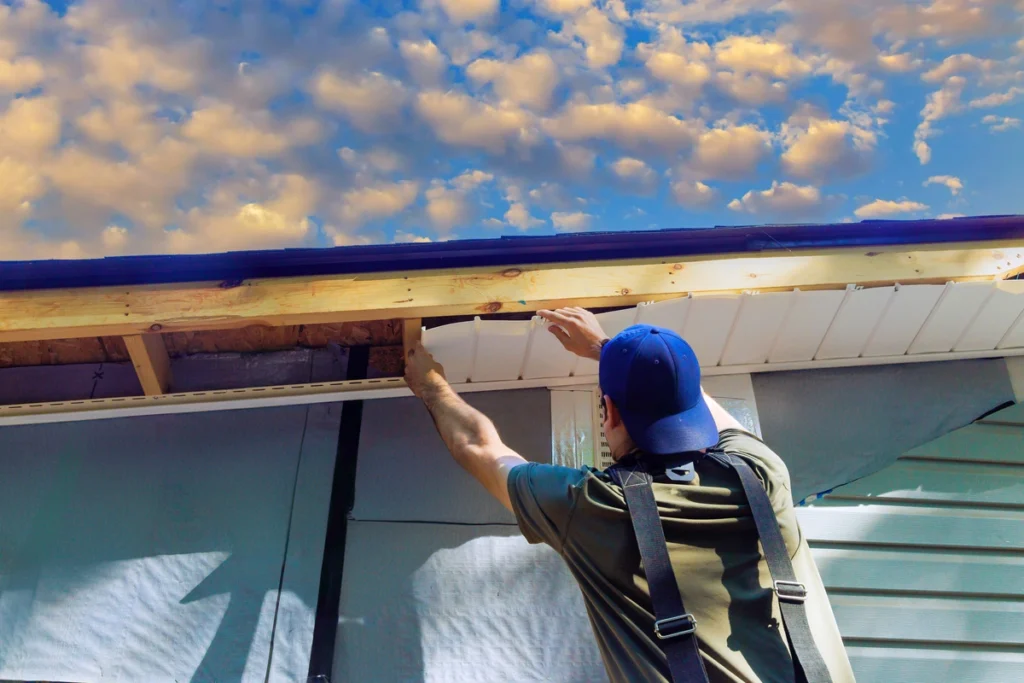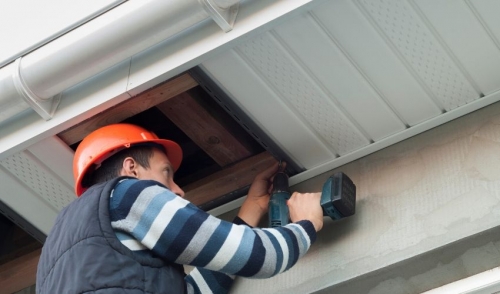Fascia & Soffit Repair for Capital Region Homes: DIY Steps, Costs, and When to Call Handyman Services Near Me

Buying your first home in Albany or anywhere in the Capital Region is exciting—but it also comes with new responsibilities along the roofline. Fascia and soffits are the unsung guardians of your eaves: they keep water, pests, and weather out while helping your attic breathe. When they fail, problems can escalate fast—think ice damming, peeling paint, attic mold, and even roof rot.
For homeowners who prefer professional help maintaining their roofline, this guide on exterior handyman repairs Albany NY explains how local experts can handle fascia, soffit, and trim repairs efficiently—protecting your home from water damage, pests, and costly structural issues year-round.
This guide explains everything a first-time homeowner needs to know about fascia and soffit repair in our climate: what these components do, how to spot early warning signs, which fixes are beginner-friendly, and when it’s smarter (and safer) to call a professional. If you’d rather not climb ladders or handle saws, A&S Home Services can assess and repair issues quickly.
Why Fascia and Soffit Maintenance Matters in the Capital Region
Albany’s seasonal swings—heavy snow, spring rains, summer heat, and fall winds—put constant stress on your roof edges. Fascia (the vertical board at the roof edge that often holds the gutters) and soffit (the horizontal panel under the eaves) play key roles:
- Moisture Defense: They help direct water away from the roof and seal gaps where wind-driven rain could enter.
- Ventilation: Vented soffits allow cool, fresh air into the attic, reducing moisture and stabilizing temperature. This helps prevent mold and ice dams.
- Structural Integrity: Fascia supports your gutters—if fascia rots, gutters can sag or pull away, leading to siding and foundation issues.
- Energy Efficiency: Proper attic ventilation reduces HVAC strain and improves comfort.
- Curb Appeal: Clean, well-painted fascia and soffit improve your home’s look and resale value.
DIY vs. Professional Repair: What’s Realistic for Beginners?

Some fascia and soffit tasks are within reach for careful first-time owners. Others are better left to seasoned pros. Use this quick guidance:
- Beginner-friendly DIY (low risk, basic tools): Repainting peeling fascia, replacing a few feet of aluminum or vinyl soffit panels, reattaching loose soffit J-channel, sealing small gaps with caulk, cleaning and securing gutter spikes/hangers.
- Intermediate DIY (moderate risk/tools): Replacing short runs (1–8 feet) of wood fascia if you’re comfortable with a circular saw and ladder safety, venting upgrades for soffits if your attic ventilation is straightforward.
- Hire a Pro (higher risk/complexity): Significant rot or structural sagging, widespread gutter failure, pest or wildlife intrusion, water stains in interior ceilings, mold, or recurring ice dams. Complex rooflines, steep pitches, or two-story access also call for professional help.
When in doubt, get a quick evaluation. The cost of a misstep (like trapping moisture in your eaves) can outweigh the price of a service visit.
Common Signs of Fascia or Soffit Damage
Spot trouble early with a seasonal check—ideally in spring and fall. Look for:
- Fascia: Peeling paint, soft or spongy spots, dark streaks under gutter corners, nail heads pulling through, gutter sagging or separations, warped boards, bird or squirrel gnaw marks.
- Soffit: Sagging or missing panels, discoloration or water stains, small holes, wasp nests, visible mold, blocked vent holes, cool-weather condensation.
- Gutter Clues: Overflow in moderate rain, frequent clogs, staining on the siding below corners, ice dams at the eaves in winter.
Pro tip: Perform checks after heavy rain or a windstorm to catch fresh leaks or loosening.
Tools & Materials You’ll Need for Basic DIY Repairs
Gather the basics before you start. Here’s a practical list for most minor fixes:
- Extension ladder (rated for your weight) and ladder stabilizer
- Safety gear: gloves, eye protection, dust mask/respirator, hearing protection (for saw use)
- Measuring tape, carpenter’s pencil, square
- Utility knife, pry bar, hammer, nail set
- Drill/driver with exterior screws and bits
- Exterior-grade caulk and caulk gun
- Exterior primer and paint (or matching aluminum/vinyl panels)
- Wood filler/epoxy (for small fascia repairs) or replacement wood/PVC fascia board
- Replacement soffit panel(s), J-channel/F-channel (for vinyl/aluminum systems)
- Gutter hangers/spikes/ferrules if you’re re-securing gutters
Choosing Materials: Wood vs. PVC vs. Aluminum
| Material | Pros | Cons | Best For |
|---|---|---|---|
| Primed Pine or Cedar (Fascia) | Affordable, paintable, easy to cut | Can rot if paint fails; needs maintenance | Budget refreshes, historic aesthetics |
| PVC (Fascia) | Rot-proof, low maintenance | Higher cost, needs expansion gaps | Long-term durability in wet climates |
| Aluminum Wrap (Fascia) | Protects wood, color-matched, resists weather | Requires brake to bend neatly; can dent | Covering sound wood to minimize maintenance |
| Vinyl/Aluminum (Soffit) | Lightweight, vented options, easy to replace sections | Can warp or dent; color matching needed | Common systems, easy DIY swaps |
| Fiber Cement (Soffit) | Durable, paintable, resists pests and rot | Heavier, harder to cut, pricier | Premium upgrades, long service life |
Infographic-Style: Beginner-Safe Repair Steps

(Imagine a simple 6-step infographic with icons: binoculars, checklist, brush, screwdriver, saw, shield.)
- Inspect (Icon: binoculars): From the ground, scan for sagging panels, peeling paint, and gutter issues. Use binoculars to spot cracks or gaps. Then perform a close inspection from a ladder, checking for soft wood using gentle pressure.
- Plan & Prep (Icon: checklist): Measure the damaged area. Note your material type and color. Buy replacement panels or lumber, caulk, primer/paint, and fasteners. Set up a stable ladder with a stabilizer.
- Clean & Dry (Icon: brush): Clear debris from the eaves and gutters. Dry the area thoroughly. Moisture trapped behind repairs leads to rot.
- Minor Soffit Fix (Icon: screwdriver): For vinyl/aluminum soffits, gently flex out the affected panel from the J-channel. Replace with a new panel cut to length. Ensure vented panels are oriented correctly to maintain airflow.
- Small Fascia Patch (Icon: saw): For a small rotted spot (under 6–8 inches), dig out damaged wood and fill with exterior wood epoxy. Prime and paint. For longer damage, cut back to sound wood and replace the board segment; seal joints and repaint.
- Seal & Protect (Icon: shield): Caulk gaps where soffit meets fascia and where fascia meets siding. Prime bare wood and apply two coats of exterior paint. Re-secure gutters with proper hangers spaced ~24–36 inches on center.
Time estimates: Small soffit panel swap (30–60 min). Minor fascia epoxy repair (1–2 hours plus dry time). Short fascia board replacement (2–4 hours).
handyman services near me: When to Search in Albany
Some scenarios signal it’s time to call a pro:
- Structural Red Flags: Widespread softness in fascia, gutter pulling away from the house, soffit sections collapsing or bowing.
- Pest Intrusion: Squirrels, bats, or birds entering through eaves; wasp nests blocking ventilation.
- Water & Mold: Interior ceiling stains near exterior walls, musty attic smell, visible mold on sheathing or rafters.
- Ice Dams Recurring: Repeated winter ice at the eaves indicates inadequate ventilation or insulation—soffit work may be part of a larger fix.
- Complex Access: Two-story work, steep slopes, or proximity to power lines.
Pros bring the right ladders, brakes for aluminum wrapping, moisture meters, and know-how to fix root causes (like poor ventilation) alongside cosmetic repairs.
Albany-Specific Tips: Weather, Ventilation, and Materials
- Freeze–Thaw Awareness: Moisture swells wood, then freezes and expands. Keep paint intact and caulk joints before winter.
- Vent Balance: Aim for balanced intake (soffit) and exhaust (ridge or gable vents). A rule of thumb is 1 square foot of net free vent area (NFVA) per 300 square feet of attic, split roughly 50/50 intake and exhaust. Always check local code and manufacturer specs.
- Material Trends: More Capital Region homes are upgrading to PVC fascia or aluminum-wrapped wood to reduce repainting and resist rot.
Comparison Chart: DIY Costs vs. Hiring a Handyman
| Task | DIY Cost (Albany area) | Pro Cost (Albany area) | Notes |
|---|---|---|---|
| Repaint 20–40 ft of fascia | $40–$120 (paint, primer, caulk) | $200–$450 | Includes surface prep; add for two-story access |
| Replace 1–2 vinyl/aluminum soffit panels | $25–$60 | $150–$300 | Color matching can affect cost |
| Replace 6–8 ft wood fascia board | $35–$120 (lumber, fasteners, paint) | $250–$600 | Pro may recommend PVC or aluminum wrap for durability |
| Re-secure sagging gutter section | $20–$60 (hangers/spikes) | $150–$350 | Extra if pitch correction or seam resealing is needed |
| Address pest entry at eaves | $15–$50 (screen, caulk) | $200–$700+ | May require wildlife control or attic remediation |
Prices vary by access, materials, and scope. Hiring out can be more cost-effective when safety risks are present or when the root cause isn’t obvious.
Value and Peace of Mind with Local Pros
Choosing local handyman services near me offers benefits beyond a quick fix:
- Correct Diagnosis: Pros identify the actual source of damage (ventilation, gutters, shingle overhang, flashing).
- Right Materials: Guidance on PVC vs. wood vs. aluminum wrap, and venting specs suited to the Capital Region.
- Safety & Warranty: Insured labor, proper ladders/equipment, and workmanship guarantees.
- Time Savings: What could take a weekend often takes a pro a few hours.
Checklist: DIY or Pro?
Use this quick-reference to decide your next step.
- If damage is under 6–8 feet and materials are straightforward (vinyl/aluminum soffit or a single wood fascia board), DIY may be fine.
- If you notice interior stains, moldy smell, critter noise, or significant rot, call a pro.
- If your home is two stories or has steep roof pitches, consider hiring out for safety.
- If gutters are mispitched or repeatedly overflowing, you likely need a pro evaluation.
- If your soffit vents look painted over or blocked, consult a pro to rebalance attic ventilation.
Beginner Mistakes to Avoid
- Sealing without Venting: Don’t close off vented soffits with solid panels or excessive caulk; you can trap moisture.
- Painting Wet Wood: Moisture under paint leads to blistering and rot. Dry fully, prime, then paint.
- Shortcuts on End Grain: Always prime/paint or cap wood end grain; it’s where moisture wicks in.
- Wrong Fasteners: Use exterior-grade screws/nails. Galvanized or stainless for longevity.
- Poor Ladder Setup: A stabilizer is essential to avoid crushing gutters or tipping.
Albany Homeowner Scenario: A Quick Q&A
- Q: My gutters overflow during average rain, and the soffit near the corner is stained. What’s going on?
- A: Likely a clogged or mispitched gutter is forcing water behind the fascia. Water then wicks into soffit material. Start with cleaning and inspecting your gutters and downspouts. If staining persists, check for fascia rot and consider a pro evaluation to correct pitch.
- Q: The soffit under my porch sags. Can I just re-nail it?
- A: Possibly—but verify the channel system isn’t damaged and that the panel hasn’t warped. If it’s vinyl/aluminum, replacing the panel and securing the J/F-channel properly is best.
- Q: Our attic feels damp in winter. Is that a soffit issue?
- A: It could be. Blocked soffit vents or inadequate intake reduce airflow and can cause condensation and ice dams. A ventilation assessment is smart.
Safety First: Ladder and Work Practices
- Use a ladder stabilizer; never rest directly on gutters.
- Maintain a 4:1 ratio angle (for every 4 feet of rise, 1 foot out).
- Keep three points of contact and don’t overreach.
- Turn off nearby exterior power where feasible; be mindful of service drops.
- Wear PPE: eye protection, gloves, and hearing protection when cutting.
Step-by-Step: Replacing a Small Fascia Section (Detailed)
- Remove Gutter Section: Mark and detach hangers in the repair zone. Carefully set the gutter aside or support it.
- Expose Fascia: Pry off any aluminum wrap. Score caulked seams with a utility knife.
- Cut Back to Sound Wood: Use a circular saw with depth set to board thickness. Cut square; avoid cutting into rafters.
- Prep Replacement: Match thickness (often 1×6, 1×8). Prime all sides and end grain.
- Install: Fasten into rafter tails with exterior screws. Keep board flush and level to ensure proper gutter pitch later.
- Seal & Finish: Caulk joints, prime cut edges, and paint two coats. Reinstall or replace gutter hangers; set a gentle slope (about 1/16–1/8 inch per 10 feet) toward downspouts.
Seasonal Maintenance Plan (Capital Region)
- Spring: Clear winter debris, inspect for ice-dam damage, touch up paint.
- Summer: Address any rot or ventilation issues in dry conditions.
- Fall: Clean gutters/leaves, ensure soffit vents are open before snow.
- Winter: Watch for ice dams; consider roof raking and attic vent checks.
Local Learning Resources
For more homeowner-friendly upkeep tips and repair walk-throughs, explore our blog. You’ll find handy guides tailored to Capital Region homes and climate.
FAQs: Fascia & Soffit Repair for First-Time Owners
- How long do fascia and soffits last?
- Painted wood fascia can last 10–20 years with maintenance. PVC and aluminum-wrapped systems can exceed 25+ years. Vinyl/aluminum soffits often last decades if properly vented and secured.
- How do I know if my soffit is vented?
- Look for perforated or slotted panels. In older homes, solid wood soffits may have round vents. If you see paint-sealed vents, they’re not functioning and need attention.
- Is PVC fascia worth it?
- PVC resists rot and reduces repainting. It expands in heat, so follow fastening and gap guidelines. It’s a solid choice in wet or shaded areas.
- Can I replace soffit panels without removing the gutters?
- Usually yes. Soffit panels slide into channels separate from the gutters. However, if fascia work is involved, you may need to temporarily remove gutter sections.
- How long does a typical repair take?
- Minor soffit panel replacement: under 1 hour. Small fascia repair/patch: 1–2 hours plus dry time. Replacing a full 8–16 ft section with repainting can span half a day to a full day.
- What’s the risk of ignoring peeling paint?
- Exposed wood absorbs moisture, leading to rot. Small paint failures often signal bigger issues like clogged gutters or failing caulk.
- What should I ask a pro?
- Ask about the root cause (venting, gutter pitch, flashing), material recommendations (PVC vs. wood vs. wrap), warranty, and whether they’ll photograph before/after.
Not Ready to DIY? Try a Light Touch First
If you want to start small, repainting and caulking a short fascia run is the lowest-risk project. If it feels beyond your comfort zone—even the ladder setup—search handyman services near me to find a local pro who can help quickly and safely.
Conclusion
Fascia and soffits are essential to your Albany home’s health—protecting from water, keeping pests out, and ensuring your attic breathes through every season. With careful inspection, the right tools, and beginner-safe steps, you can tackle small fixes confidently. But when you see rot spreading, soffit sagging, pest entry, or signs of attic moisture, it’s time to call a trusted professional. For friendly, local help and durable results, reach out to A&S Home Services.

